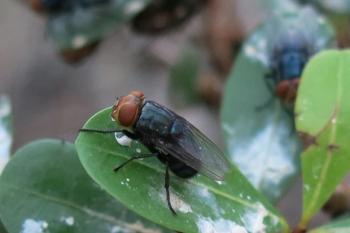
Breeding soundness exam renders effective data pool
A proper exam can detect physical and hereditary faults as well as assess mating behavior
Prior to the start of the breeding season, each stallion in a breeding program should undergo a breeding soundness examination.
Mare in estrous. At this time there is not any single physical or seminal measurement that is satisfactorily correlated with fertility. The best measure of a stallion's fertility is the number of pregnancies per cycle.
This also holds true for new stallions entering a breeding program and for stallions prior to purchase.
The breeding soundness examination is designed to detect physical and hereditary faults as well as to assess mating behavior and ability. In addition, semen parameters are evaluated.
Baseline reference
The ultimate purpose of the examination is to get baseline information on a particular individual, which can be used for comparison when suspected problems arise. In addition, stallion prospects can be selected that hopefully will have the ability to render 75 percent of 40 or more mares pregnant in a natural breeding program or 120 mares in an artificial breeding program.
If stallions are to be used in an artificial breeding program, at the time of the breeding soundness examination, semen can also be evaluated for slow-cooled shipment and also for semen freezing, if applicable.
Breeding phantom
At this time there is not any single physical or seminal measurement that is satisfactorily correlated with fertility. The best measure of a stallion's fertility is the number of pregnancies per cycle.
Initial history
The examination should begin with a history of the stallion concerning health records and reproductive records. Historical data can provide insight into the overall fertility and health of the stallion.
Along with this review, a general physical examination should be conducted along with any appropriate blood samples to verify health status (Coggins Test, EVA, CBC, etc.). As part of the physical exam, the external genitalia can be evaluated. Testicles should be palpated for any abnormalities and measured (length, width, height and total scrotal width). Testicular size and volume is directly correlated to sperm production.
Calculations
Volume can be calculated by using the following formula: V=4/3sx1/2(LxWxH). Volume is expressed in cubic centimeters and total volume is the sum of the volumes of each testicle. Grams of testicular tissue is equivalent to cc's. Therefore a total volume of 250cc is the same as 250 grams of tissue.
A normal stallion will produce approximately 16 to 18 million sperm per gram of tissue at daily sperm output, if the testicles are functioning normally. This estimation can be compared to actual sperm numbers to ascertain the efficiency of the testicular production.
Semen collection
The next step in the breeding soundness examination is the collection of semen.
Generally, two samples are collected one hour apart. The second sample is usually about the same volume as the first, but has 50 percent of the number of sperm. During this collection of semen, behavior and mating ability can be assessed. Aerobic bacterial cultures are obtained prior to semen to collection from the penis, fossa glands, pre-ejaculatory urethra and post-ejaculatory urethra.
To collect the semen, a mare in estrous or an ovariectomized mare can be used although there can be some risk factors involved. If the stallion is trained to a phantom or dummy, this would be the preferred method of collection. The stallion's penis is washed with warm water only and semen is collected in an artificial vagina of suitable type. It is extremely important that the sample not be exposed to cold temperatures and anything coming in contact with the sample be warmed to body temperature.
An aliquot of the sample is evaluated for concentration of spermatozoa and the volume of ejaculate recorded (volume x concentration = total number of sperm). Next a measured portion of semen is mixed with a suitable semen extender so that motility (both total and progressive) can be estimated. Morphology of spermatozoa is done next and normal sperm and various defects are recorded. Cytology of the sample can be done to look for inflammatory cells.
All of the above are repeated with the second sample.
Evaluation
If appropriate, an insemination dose of semen can be prepared and placed in an Equitainer or similar slow cooling device and evaluated at 24 and 48 hours to monitor the ability of the stallion's semen to cool and be transported. A portion of this sample can also be placed at room temperature in the dark and longevity of spermatozoa assessed at 24 and 48 hours.
Table 1: Minimum Number of Morphological Normal Progressively Motile Sperm by the Month
It is generally considered that a satisfactory breeding stallion produces 1 billion progressively motile sperm in the second ejaculate collected one hour after the first (see table). In addition, the stallion should exhibit good libido and mating ability.
Other considerations are:
- Two testes fully distended within the scrotum.
- Total scrotal width equal to or greater than 80 mm.
- Negative Coggins and EVA
- 50 percent or greater morphologically normal sperm.
- No evidence of inflammatory lesions or infection of external genitalia.
Bacteria recovered from swabs are considered to be mixed and normal in nature.
With the above information, a more informed opinion can be formulated about the apparent fertility of the stallion. The examination does not predict the stallion's fertility but instead gives a reference point when compared to stallions of known fertility. Noted theriogenologist Dr. Robert Kenney has a "formula" for the apparent fertility of a stallion: apparent fertility of stallion = inherent fertility of stallion + inherent fertility of mares + management + season.
This is a brief overview of the examination. Ancillary tests may be indicated to further complement the exam. These may include ultrasound of the testes and/or internal accessory sex gland, sperm chromatin structure assay and hormonal profiles.
Newsletter
From exam room tips to practice management insights, get trusted veterinary news delivered straight to your inbox—subscribe to dvm360.





